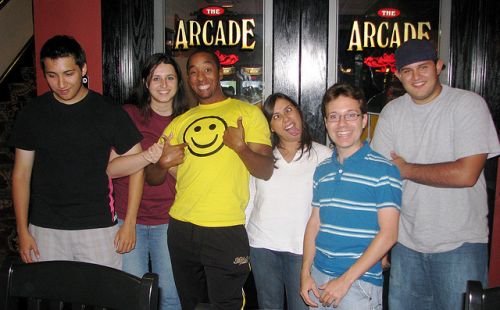Introduction to Adolescense
Learning Objectives
At the end of this lesson, you will be able to:
- Summarize physical growth and development during adolescence
- Describe cognitive milestones during adolescence
- Explain why adolescence is a period of heightened risk taking
- Explain social development and social changes during adolescence
- Describe identity formation during adolescence
- Explain the role that aggression, anxiety, and depression play in adolescent development
- Describe diversity in adolescent development
Adolescence is a period that begins with puberty and ends with the transition to adulthood (approximately ages 10–20). Physical changes associated with puberty are triggered by hormones. Cognitive changes include improvements in complex and abstract thought, as well as development that happens at different rates in distinct parts of the brain and increases adolescents’ propensity for risky behavior because increases in sensation-seeking and reward motivation precede increases in cognitive control. Adolescents’ relationships with parents go through a period of redefinition in which adolescents become more autonomous, and aspects of parenting, such as distal monitoring and psychological control, become more salient. Peer relationships are important sources of support and companionship during adolescence yet can also promote problem behaviors. Same-sex peer groups evolve into mixed-sex peer groups, and adolescents’ romantic relationships tend to emerge from these groups. Identity formation occurs as adolescents explore and commit to different roles and ideological positions. Nationality, gender, ethnicity, socioeconomic status, religious background, sexual orientation, and genetic factors shape how adolescents behave and how others respond to them, and are sources of diversity in adolescence.
Adolescence Defined
Adolescence is a developmental stage that has been defined as starting with puberty and ending with the transition to adulthood (approximately ages 10–20). Adolescence has evolved historically, with evidence indicating that this stage is lengthening as individuals start puberty earlier and transition to adulthood later than in the past. Puberty today begins, on average, at age 10–11 years for girls and 11–12 years for boys. This average age of onset has decreased gradually over time since the 19th century by 3–4 months per decade, which has been attributed to a range of factors including better nutrition, obesity, increased father absence, and other environmental factors (Steinberg, 2013[1]). Completion of formal education, financial independence from parents, marriage, and parenthood have all been markers of the end of adolescence and beginning of adulthood, and all of these transitions happen, on average, later now than in the past. In fact, the prolonging of adolescence has prompted the introduction of a new developmental period called emerging adulthood that captures these developmental changes out of adolescence and into adulthood, occurring from approximately ages 18 to 29 (Arnett, 2000[2]).

References
Arnett, J. J. (2000). Emerging adulthood: A theory of development from the late teens through the twenties. American Psychologist, 55, 469–480.
Steinberg, L. (2013). Adolescence (10th ed.). New York, NY: McGraw-Hill.
Stattin, H., & Kerr, M. (2000). Parental monitoring: A reinterpretation. Child Development, 71, 1072–1085.
Barber, B. K. (1996). Parental psychological control: Revisiting a neglected construct. Child Development, 67, 3296–3319.
Dishion, T. J., & Tipsord, J. M. (2011). Peer contagion in child and adolescent social and emotional development. Annual Review of Psychology, 62, 189–214.
Brown, B. B., & Larson, J. (2009). Peer relationships in adolescence. In R. M. Lerner & L. Steinberg (Eds.), Handbook of adolescent psychology (pp. 74–103). New York, NY: Wiley.
Connolly, J., Furman, W., & Konarski, R. (2000). The role of peers in the emergence of heterosexual romantic relationships in adolescence. Child Development, 71, 1395–1408.
Furman, W., & Shaffer, L. (2003). The role of romantic relationships in adolescent development. In P. Florsheim (Ed.), Adolescent romantic relations and sexual behavior: Theory, research, and practical implications (pp. 3–22). Mahwah, NJ: Erlbaum.
Russell, S. T., Clarke, T. J., & Clary, J. (2009). Are teens “post-gay”? Contemporary adolescents’ sexual identity labels. Journal of Youth and Adolescence, 38, 884–890. ↵Erikson, E. H. (1968). Identity, youth, and crisis. New York, NY: Norton.
Marcia, J. E. (1966). Development and validation of ego identity status. Journal of Personality and Social Psychology, 3, 551–558.
Phinney, J. (1989). Stages of ethnic identity in minority group adolescents. Journal of Early Adolescence, 9, 34–49.
Patterson, G. R. (1982). Coercive family process. Eugene, OR: Castalia Press.
Moffitt, T. E. (1993). Adolescence-limited and life course persistent antisocial behavior: Developmental taxonomy. Psychological Review, 100, 674–701.
Rudolph, K. D. (2009). The interpersonal context of adolescent depression. In S. Nolen-Hoeksema & L. M. Hilt (Eds.), Handbook of depression in adolescents (pp. 377–418). New York, NY: Taylor and Francis.
American Psychiatric Association. (2013). Diagnostic and statistical manual of mental disorders (5th ed.). Arlington, VA: American Psychiatric Publishing.
Rudolph, K. D. (2009). The interpersonal context of adolescent depression. In S. Nolen-Hoeksema & L. M. Hilt (Eds.), Handbook of depression in adolescents (pp. 377–418). New York, NY: Taylor and Francis.
Eccles, J. S., & Roeser, R. W. (2011). Schools as developmental contexts during adolescence. Journal of Research on Adolescence, 21, 225–241.
Belsky, J., & Pluess, M. (2009). Beyond diathesis-stress: Differential susceptibility to environmental influences. Psychological Bulletin, 135, 885–908.
Dick, D. M., Meyers, J. L., Latendresse, S. J., Creemers, H. E., Lansford, J. E., … Huizink, A. C. (2011). CHRM2, parental monitoring, and adolescent externalizing behavior: Evidence for gene-environment interaction. Psychological Science, 22, 481–489.

